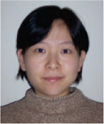Two-Photon Polymerization for Three-Dimensional Photonic Devices in Polymers and Nanocomposites
Baohua Jia A , Jiafang Li A and Min Gu A BA Centre for Micro-Photonics and CUDOS, Faculty of Engineering and Industrial Sciences, Swinburne University of Technology, Hawthorn, VIC 3122, Australia.
B Corresponding author. Email: mgu@swin.edu.au

Baohua Jia, born in 1977, received both her B.Sc. and M.Sc. degrees from Nankai University, China. She received her Ph.D. in optical science from Swinburne University of Technology, Australia, in 2006. She is now the project manager for the Australian Research Council Centre of Excellence for Ultrahigh-Bandwidth Devices for Optical Systems (CUDOS). Her research interests include femtosecond fabrication of novel photonic crystals using both photo-polymer materials and high refractive index materials, investigation of super-prism and non-linear effects inside three-dimensional photonic crystals, active photonic devices facilitated with quantum dots infiltration into photonic crystals, and near-field characterization of photonic crystals. She is the author or coauthor of more than 40 scientific publications. |

Jiafang Li received his B.Sc. and M.Sc. in Physics from Nankai University, China, majoring in optical fibre sources for telecommunications applications. In 2005, he started his Ph.D. with Professor Min Gu at the Centre for Micro-Photonics, Swinburne University of Technology. His work focusses on the exploration of the functionalities of three-dimensional polymeric photonic crystals in near-infrared wavelength range by incorporating the unique properties of semiconductor quantum dots. |

Min Gu, an elected Fellow of the Australian Academy of Science, Fellow of the Australian Academy of Technological Sciences and Engineering, and Cheung Kong Chair Professor of the Ministry for Eduction (China), gained a Ph.D. degree in optics from the Chinese Academy of Sciences in 1988 and a professorship in 1998 in Australia at the age of 38. He is the director of the Centre for Micro-Photonics at Swinburne University of Technology and a Node Director of the Australian Research Council Centre of Excellence for Ultrahigh-Bandwidth Devices for Optical Systems (CUDOS). He has been a Fellow of SPIE since 2003. He has published over 450 articles (including over 250 papers in internationally refereed journals) in photonic crystals and devices, nanophotonics/biophotonics, micro/nanofabrication, confocal and multiphoton microscopy, laser tweezers, and multi-dimensional optical data storage. He is/was Vice President (2004–present), President (2002–2004), and the Regional Council member (2000–present) of the International Society of Optics within Life Sciences and Vice Present of the International Commission for Optics (2005–present). He has received numerous awards for excellence. |
Australian Journal of Chemistry 60(7) 484-495 https://doi.org/10.1071/CH06484
Submitted: 20 December 2006 Accepted: 5 April 2007 Published: 9 July 2007
Abstract
Fabrication of micro- or nano-scale photonic devices in polymer materials to control and manipulate light propagation represents a hot topic nowadays. Compared with conventional semiconductor materials, polymers are easy to prepare and have the flexibility of incorporating active materials to realise various functionalities. As one of the most powerful tools in micro-optical fabrication, the two-photon polymerization technique has been widely employed recently to produce multifarious photonic devices, particularly the photonic crystals, which are promising candidates for integrated optical devices. In this article the recent advances in the fabrication of three-dimensional photonic devices such as diffractive optical elements, photonic crystals, and superprisms in polymer materials using the two-photon polymerization technique are reviewed. In particular, the fabrication of photonic crystals in nanocomposite polymers, which are formed by incorporating nanocrystal quantum dots into polymer materials, is demonstrated, providing an interesting physical platform for the investigation into new types of active micro-devices.
Acknowledgments
This work was produced with the assistance of the Australian Research Council (ARC) under the Centres of Excellence Program. CUDOS (Centre for Ultrahigh-Bandwidth Devices for Optical Systems) is an ARC Centre of Excellence. The authors thank Dr Martin Straub, Dr Nguyen Le Huong, Dr Shuhui Wu, and Dr Jesper Serbin for their contributions and discussions on this topic.
[1]
S. Maruo,
K. Ikuta,
H. Korogi,
Appl. Phys. Lett. 2003, 82, 133.
| Crossref | GoogleScholarGoogle Scholar |
| Crossref | GoogleScholarGoogle Scholar |
| Crossref | GoogleScholarGoogle Scholar |
| Crossref | GoogleScholarGoogle Scholar |
| Crossref | GoogleScholarGoogle Scholar |
| Crossref | GoogleScholarGoogle Scholar |
| Crossref | GoogleScholarGoogle Scholar |
| Crossref | GoogleScholarGoogle Scholar |
| Crossref | GoogleScholarGoogle Scholar |
| Crossref | GoogleScholarGoogle Scholar |
| Crossref | GoogleScholarGoogle Scholar |
| Crossref | GoogleScholarGoogle Scholar |
| Crossref | GoogleScholarGoogle Scholar |
| Crossref | GoogleScholarGoogle Scholar |
| Crossref | GoogleScholarGoogle Scholar |
| Crossref | GoogleScholarGoogle Scholar |
| Crossref | GoogleScholarGoogle Scholar |
| Crossref | GoogleScholarGoogle Scholar |
| Crossref | GoogleScholarGoogle Scholar |
| Crossref | GoogleScholarGoogle Scholar |
| Crossref | GoogleScholarGoogle Scholar |
| Crossref | GoogleScholarGoogle Scholar |
| Crossref | GoogleScholarGoogle Scholar |
| Crossref | GoogleScholarGoogle Scholar |
| Crossref | GoogleScholarGoogle Scholar |
| Crossref | GoogleScholarGoogle Scholar |
| Crossref | GoogleScholarGoogle Scholar |
| Crossref | GoogleScholarGoogle Scholar |
| Crossref | GoogleScholarGoogle Scholar |
| Crossref | GoogleScholarGoogle Scholar |
| Crossref | GoogleScholarGoogle Scholar |
| Crossref | GoogleScholarGoogle Scholar |



